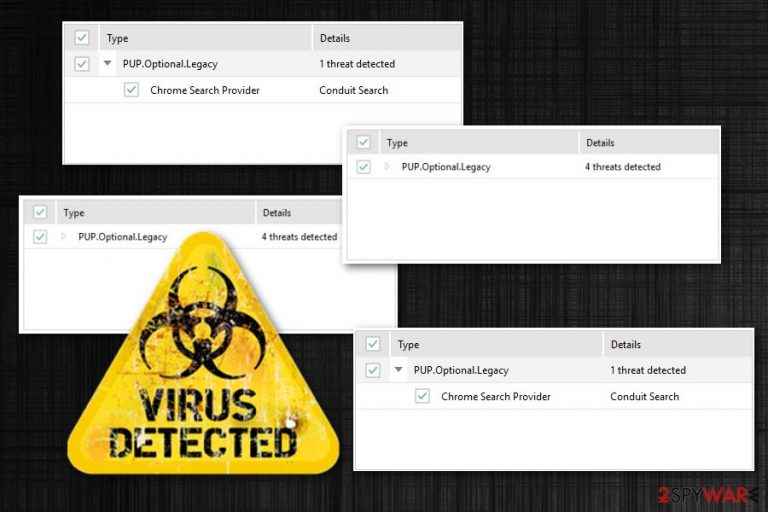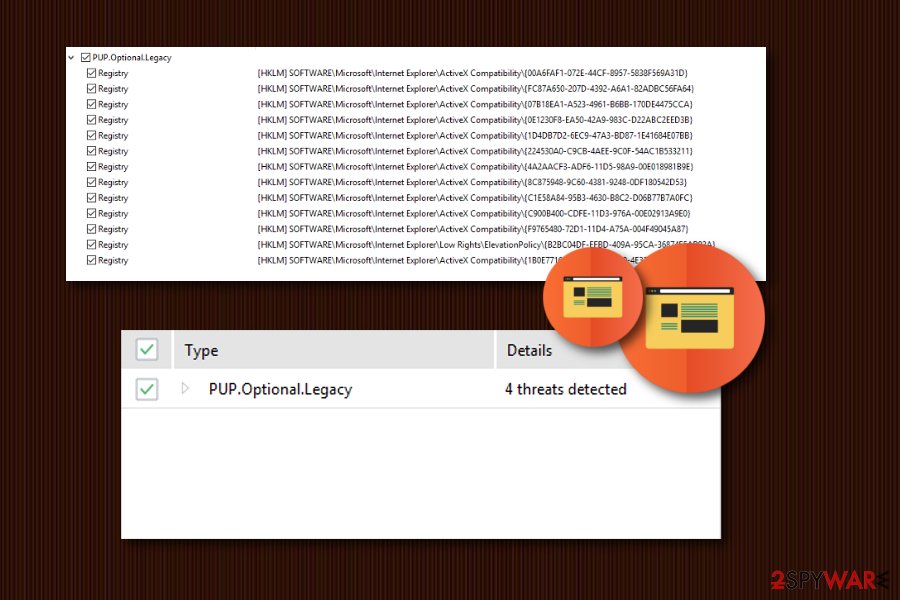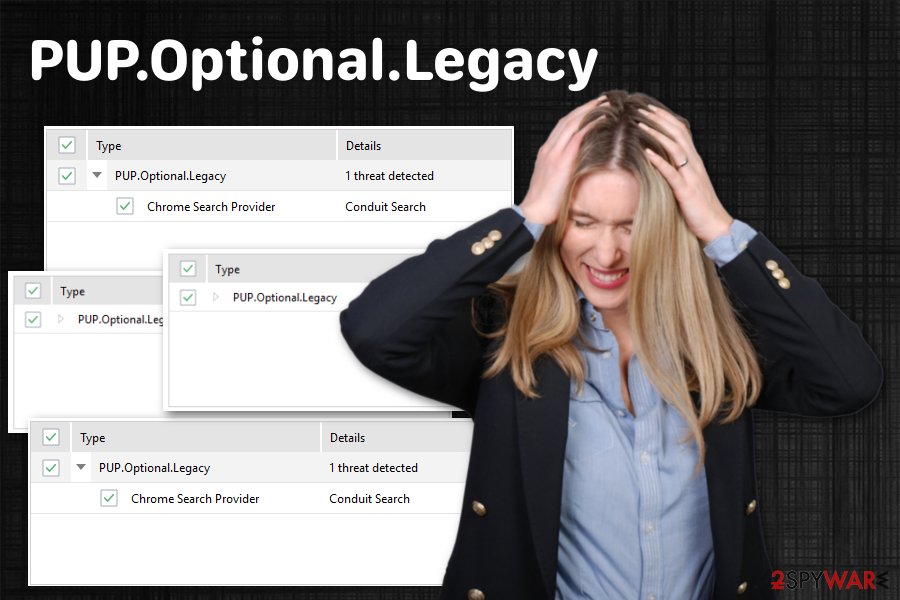PUP.Optional.Legacy (Removal Guide) - updated May 2020
PUP.Optional.Legacy Removal Guide
What is PUP.Optional.Legacy?
PUP.Optional.Legacy is a generic name of adware found on the computer

PUP.Optional.Legacy is a term used to indicate the potentially unwanted program on the computer. The detection name has been used by AdwCleaner and Malwarebytes anti-malware, so if you are using another anti-malware tool, you can receive different results, e.g. PUP.Optional.Legacy[key], Conduit, or Chrome Search Provider. However, the main idea means the same – your device is infected with the PUP. The warning about this intruder may appear out of nowhere because of the initial infiltration moment is usually not related to any adware-type symptoms. Adware programs, similar to other potentially unwanted applications, infiltrate system through bundling and then start delivering intrusive commercial content to your browser directly.[1] However, additional background processes that are used for victims' tracking can make your computer run slow.
| Name | PUP.Optional.Legacy |
|---|---|
| Type | Adware |
| Also known as | PUP.Optional.Legacy[key]; Chrome Search Provider; Conduit |
| Detected by | AdwCleaner, Malwarebytes |
| Symptoms | Intrusive commercial content, rerouted online traffic |
| Distribution | Software bundles, deceptive advertisements |
| Elimination | Install FortectIntego for PUP.Optional.Legacy removal and system cleaning |
PUP.Optional.Legacy is a name that appears on the screen as a possible threat. Your antivirus may display a different name, but the main issue is still infiltration of the unwanted program on your system and background activities. If you already noticed some changes in the speed of your browser or device, you may be aware that the program acts intrusive. You can associate these symptoms with adware-type intruder:
- banners injected on commonly visited sites;
- pop-ups appearing constantly;
- random text turning into hyperlinks;
- additional extensions, bookmarks or toolbars installed on the browser;
- commonly visited pages looking unfamiliar;
- homepage or search engine changed.
Although PUP.Optional.Legacy virus may deliver useful information about deals, offers, and coupons this is not the program you want to keep on the system. Since there is no value, you need to eliminate all related programs and files from the computer if you want to keep working on your device without the risk.

Users online[2] complain about PUP.Optional.Legacy adware activity and persistence. It appears that developers install additional files on the system and even make changes on the registry to keep this PUP removal difficult. Also, all those bookmarks, toolbars, and extensions on your browser keep the intruder on your computer. You should manually remove them all and change browser settings to default, so there is no possibility of infection repetition.
Also, browsing online about this cyber threat revealed that detection might look like PUP.Optional.Legacy but with the additional name of software at the end. There are tons of different detections similar to this one, such as PUP.Optional.InstallCore or PUP.Optional.Yontoo.
The main thing you need to remember is that PUP.Optional.Legacy removal gives the best results when you use anti-malware tools for the job. It is because malware-fighting programs indicate all possible threats and terminate them altogether. A full system scan also improves the speed of your machine.
Remove PUP.Optional.Legacy as researchers[3] advises you to – using tools like FortectIntego or the program you already received the alert from. We also have a few other options down below for reputable tools. Remember that PUPs have a distinct feature of tracking users' data and starts collecting information about your browsing habits and most viewed sites or even location immediately after infiltration. Clean the system thoroughly and forget about redirects, pop-up ads, and other unwanted content.

Software bundles distribute unwanted applications
In the world of cyber threats, developers employ various distribution techniques to spread their products around the internet. The most common way of PUP distribution is software bundling[4] when freeware providers pack their applications alongside unwanted programs like hijackers or adware. You cannot avoid this infiltration if you choose Default or Quick installations because the optional step is hidden when you skip through the process.
When opting for Advanced or Custom installations, you are given the opportunity to de-select intrusive applications and proceed with the installation of your necessary software. However, you can also avoid these intrusive programs if you choose your sources wisely. Using p2p services[5] or non-official download websites cannot give you positive results all the time.
Another safety tip would be to download and install an antivirus tool that includes threat detection and removal functions. Make sure that this software is always updated, otherwise, some flaws might appear and prevent you from securing the system fully. If you take care of your antivirus software properly, it will be very handy for you.
Terminate PUP.Optional.Legacy and other related processes or programs
When it comes to PUP.Optional.Legacy removal it is not that difficult. The name of detection frustrates people, and possible solutions may look too tricky. But we have a thorough virus elimination guide down below that gives you tips on every step of the process.
Remove PUP.Optional.Legacy using anti-malware tools and then check your browser settings for any unwanted changes. You need to perform this process with the help of professional tools to make sure no malware is left behind. In the future, keep your anti-malware up-to-date, so every possible threat is detected in time.
PUP.Optional.Legacy adware is not a program you should keep on your computer system. Unwanted activities will supposedly be performed on your computer and browser such as Chrome, Firefox, Edge, Explorer, and Safari might experience suspicious changes. Remove the adware as soon as possible to bring back the stability of your computer system and web browser applications.
You may remove virus damage with a help of FortectIntego. SpyHunter 5Combo Cleaner and Malwarebytes are recommended to detect potentially unwanted programs and viruses with all their files and registry entries that are related to them.
Getting rid of PUP.Optional.Legacy. Follow these steps
Uninstall from Windows
Clean your device and forget about PUP.Optional.Legacy adware alerts
Instructions for Windows 10/8 machines:
- Enter Control Panel into Windows search box and hit Enter or click on the search result.
- Under Programs, select Uninstall a program.

- From the list, find the entry of the suspicious program.
- Right-click on the application and select Uninstall.
- If User Account Control shows up, click Yes.
- Wait till uninstallation process is complete and click OK.

If you are Windows 7/XP user, proceed with the following instructions:
- Click on Windows Start > Control Panel located on the right pane (if you are Windows XP user, click on Add/Remove Programs).
- In Control Panel, select Programs > Uninstall a program.

- Pick the unwanted application by clicking on it once.
- At the top, click Uninstall/Change.
- In the confirmation prompt, pick Yes.
- Click OK once the removal process is finished.
Delete from macOS
Remove items from Applications folder:
- From the menu bar, select Go > Applications.
- In the Applications folder, look for all related entries.
- Click on the app and drag it to Trash (or right-click and pick Move to Trash)

To fully remove an unwanted app, you need to access Application Support, LaunchAgents, and LaunchDaemons folders and delete relevant files:
- Select Go > Go to Folder.
- Enter /Library/Application Support and click Go or press Enter.
- In the Application Support folder, look for any dubious entries and then delete them.
- Now enter /Library/LaunchAgents and /Library/LaunchDaemons folders the same way and terminate all the related .plist files.

Remove from Microsoft Edge
Delete unwanted extensions from MS Edge:
- Select Menu (three horizontal dots at the top-right of the browser window) and pick Extensions.
- From the list, pick the extension and click on the Gear icon.
- Click on Uninstall at the bottom.

Clear cookies and other browser data:
- Click on the Menu (three horizontal dots at the top-right of the browser window) and select Privacy & security.
- Under Clear browsing data, pick Choose what to clear.
- Select everything (apart from passwords, although you might want to include Media licenses as well, if applicable) and click on Clear.

Restore new tab and homepage settings:
- Click the menu icon and choose Settings.
- Then find On startup section.
- Click Disable if you found any suspicious domain.
Reset MS Edge if the above steps did not work:
- Press on Ctrl + Shift + Esc to open Task Manager.
- Click on More details arrow at the bottom of the window.
- Select Details tab.
- Now scroll down and locate every entry with Microsoft Edge name in it. Right-click on each of them and select End Task to stop MS Edge from running.

If this solution failed to help you, you need to use an advanced Edge reset method. Note that you need to backup your data before proceeding.
- Find the following folder on your computer: C:\\Users\\%username%\\AppData\\Local\\Packages\\Microsoft.MicrosoftEdge_8wekyb3d8bbwe.
- Press Ctrl + A on your keyboard to select all folders.
- Right-click on them and pick Delete

- Now right-click on the Start button and pick Windows PowerShell (Admin).
- When the new window opens, copy and paste the following command, and then press Enter:
Get-AppXPackage -AllUsers -Name Microsoft.MicrosoftEdge | Foreach {Add-AppxPackage -DisableDevelopmentMode -Register “$($_.InstallLocation)\\AppXManifest.xml” -Verbose

Instructions for Chromium-based Edge
Delete extensions from MS Edge (Chromium):
- Open Edge and click select Settings > Extensions.
- Delete unwanted extensions by clicking Remove.

Clear cache and site data:
- Click on Menu and go to Settings.
- Select Privacy, search and services.
- Under Clear browsing data, pick Choose what to clear.
- Under Time range, pick All time.
- Select Clear now.

Reset Chromium-based MS Edge:
- Click on Menu and select Settings.
- On the left side, pick Reset settings.
- Select Restore settings to their default values.
- Confirm with Reset.

Remove from Mozilla Firefox (FF)
Fix your Firefox after PUP.Optional.Legacy removal and reset the browser to default so additional apps can be removed
Remove dangerous extensions:
- Open Mozilla Firefox browser and click on the Menu (three horizontal lines at the top-right of the window).
- Select Add-ons.
- In here, select unwanted plugin and click Remove.

Reset the homepage:
- Click three horizontal lines at the top right corner to open the menu.
- Choose Options.
- Under Home options, enter your preferred site that will open every time you newly open the Mozilla Firefox.
Clear cookies and site data:
- Click Menu and pick Settings.
- Go to Privacy & Security section.
- Scroll down to locate Cookies and Site Data.
- Click on Clear Data…
- Select Cookies and Site Data, as well as Cached Web Content and press Clear.

Reset Mozilla Firefox
If clearing the browser as explained above did not help, reset Mozilla Firefox:
- Open Mozilla Firefox browser and click the Menu.
- Go to Help and then choose Troubleshooting Information.

- Under Give Firefox a tune up section, click on Refresh Firefox…
- Once the pop-up shows up, confirm the action by pressing on Refresh Firefox.

Remove from Google Chrome
Get rid of PUP.Optional.Legacy related extensions, bookmarks or toolbars and block unwanted notifications by following this guide:
Delete malicious extensions from Google Chrome:
- Open Google Chrome, click on the Menu (three vertical dots at the top-right corner) and select More tools > Extensions.
- In the newly opened window, you will see all the installed extensions. Uninstall all the suspicious plugins that might be related to the unwanted program by clicking Remove.

Clear cache and web data from Chrome:
- Click on Menu and pick Settings.
- Under Privacy and security, select Clear browsing data.
- Select Browsing history, Cookies and other site data, as well as Cached images and files.
- Click Clear data.

Change your homepage:
- Click menu and choose Settings.
- Look for a suspicious site in the On startup section.
- Click on Open a specific or set of pages and click on three dots to find the Remove option.
Reset Google Chrome:
If the previous methods did not help you, reset Google Chrome to eliminate all the unwanted components:
- Click on Menu and select Settings.
- In the Settings, scroll down and click Advanced.
- Scroll down and locate Reset and clean up section.
- Now click Restore settings to their original defaults.
- Confirm with Reset settings.

Delete from Safari
Remove unwanted extensions from Safari:
- Click Safari > Preferences…
- In the new window, pick Extensions.
- Select the unwanted extension and select Uninstall.

Clear cookies and other website data from Safari:
- Click Safari > Clear History…
- From the drop-down menu under Clear, pick all history.
- Confirm with Clear History.

Reset Safari if the above-mentioned steps did not help you:
- Click Safari > Preferences…
- Go to Advanced tab.
- Tick the Show Develop menu in menu bar.
- From the menu bar, click Develop, and then select Empty Caches.

After uninstalling this potentially unwanted program (PUP) and fixing each of your web browsers, we recommend you to scan your PC system with a reputable anti-spyware. This will help you to get rid of PUP.Optional.Legacy registry traces and will also identify related parasites or possible malware infections on your computer. For that you can use our top-rated malware remover: FortectIntego, SpyHunter 5Combo Cleaner or Malwarebytes.
How to prevent from getting adware
Do not let government spy on you
The government has many issues in regards to tracking users' data and spying on citizens, so you should take this into consideration and learn more about shady information gathering practices. Avoid any unwanted government tracking or spying by going totally anonymous on the internet.
You can choose a different location when you go online and access any material you want without particular content restrictions. You can easily enjoy internet connection without any risks of being hacked by using Private Internet Access VPN.
Control the information that can be accessed by government any other unwanted party and surf online without being spied on. Even if you are not involved in illegal activities or trust your selection of services, platforms, be suspicious for your own security and take precautionary measures by using the VPN service.
Backup files for the later use, in case of the malware attack
Computer users can suffer from data losses due to cyber infections or their own faulty doings. Ransomware can encrypt and hold files hostage, while unforeseen power cuts might cause a loss of important documents. If you have proper up-to-date backups, you can easily recover after such an incident and get back to work. It is also equally important to update backups on a regular basis so that the newest information remains intact – you can set this process to be performed automatically.
When you have the previous version of every important document or project you can avoid frustration and breakdowns. It comes in handy when malware strikes out of nowhere. Use Data Recovery Pro for the data restoration process.
- ^ Sabrina Berkenkopf. Potentially unwanted programs:much more than just annoying. Gdatasoftware. Antivirus and internet security.
- ^ Online discussion about PUP. Mozilla. Firefox support forum.
- ^ Avirus. Avirus. Spyware related news.
- ^ Bundled software. Techopedia. Where information technology and business meet.
- ^ Will Kenton. Peer-to-Peer (P2P) Service. Investopedia. Relevant info.
